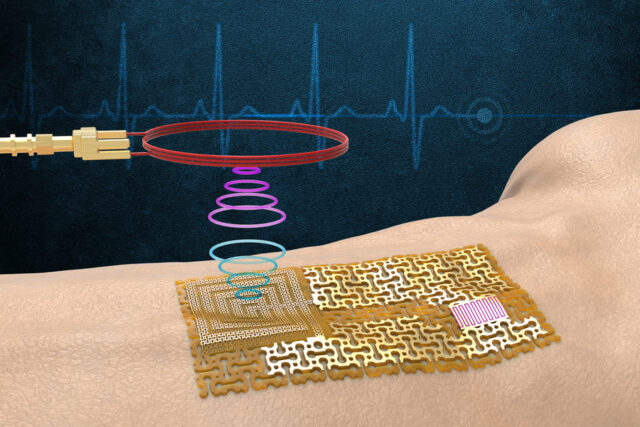
MIT Engineers Create ‘E-Skin’ That Wirelessly Monitors Biological Signals
As wireless sensors become more affordable and accessible, people are increasingly looking for ways to use them to monitor their biology. Smartwatches and fitness bands routinely update users on their heart rate, blood oxygen levels, and exercise statistics, while certain body-mounted sensors give doctors insight into a patient’s vascular, endocrine, and even neurological function. But there’s one caveat to the way these sensors are made: semiconductor bulk. The sensors typically communicate via Bluetooth using chips powered by miniature batteries, and these configurations take up a great deal of space.
MIT’s latest wearable creation doesn’t contain a chip at all but still functions wirelessly. Referred to as “” for its flexibility and durability, the sensor “conforms to the skin like electronic Scotch tape.” It’s powered by a thin film of single-crystalline gallium nitride, which can respond to mechanical strain with an electrical signal and to an electrical impulse with mechanical vibration. Paired with a conductive layer of gold, this two-way method of communication allowed the researchers to create an e-skin capable of sensing biological signals and transmitting information wirelessly.

(Image: MIT)
The resulting sensor uses acoustic waves to pick up on a person’s heart rate and the concentration of certain biomarkers, like salt, present in a person’s sweat. While most people associate sweat with a particularly hot day or a good workout, it can also be used to help diagnose health conditions like tuberculosis, acute anxiety, and metabolic disorders. Even still, the sensor can be tweaked to pick up on different biomarkers.
“We showed sodium sensing, but if you change the sensing membrane, you could detect any target biomarker, such as glucose, or cortisol related to stress levels,” Jun Min Suh, the study’s co-author, and an MIT postdoc.
The e-skin’s design is reminiscent of the stamp-sized we reported on earlier this month, which were also designed by scientists at MIT. While those are intended for imaging and not biometric data measurement, they, too, indicate a big step forward in the realm of wearable medical technology. Both stick to the body like a band-aid and transmit important medical information to an external device without the need for a battery. Someday, the creators of the e-skin hope, discreet wearables like this one will convey information directly to the wearer’s smartphone.
Now Read: